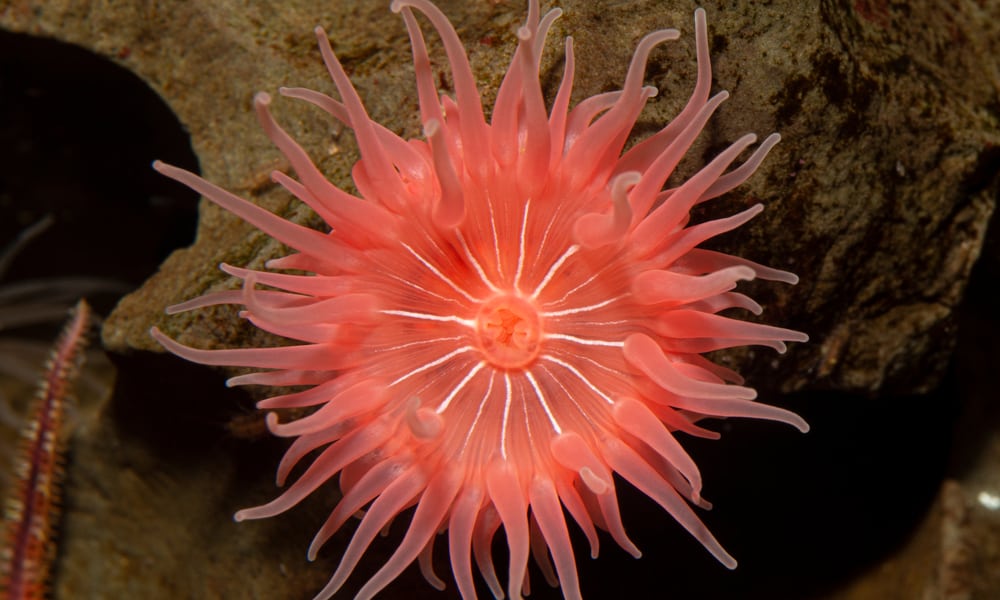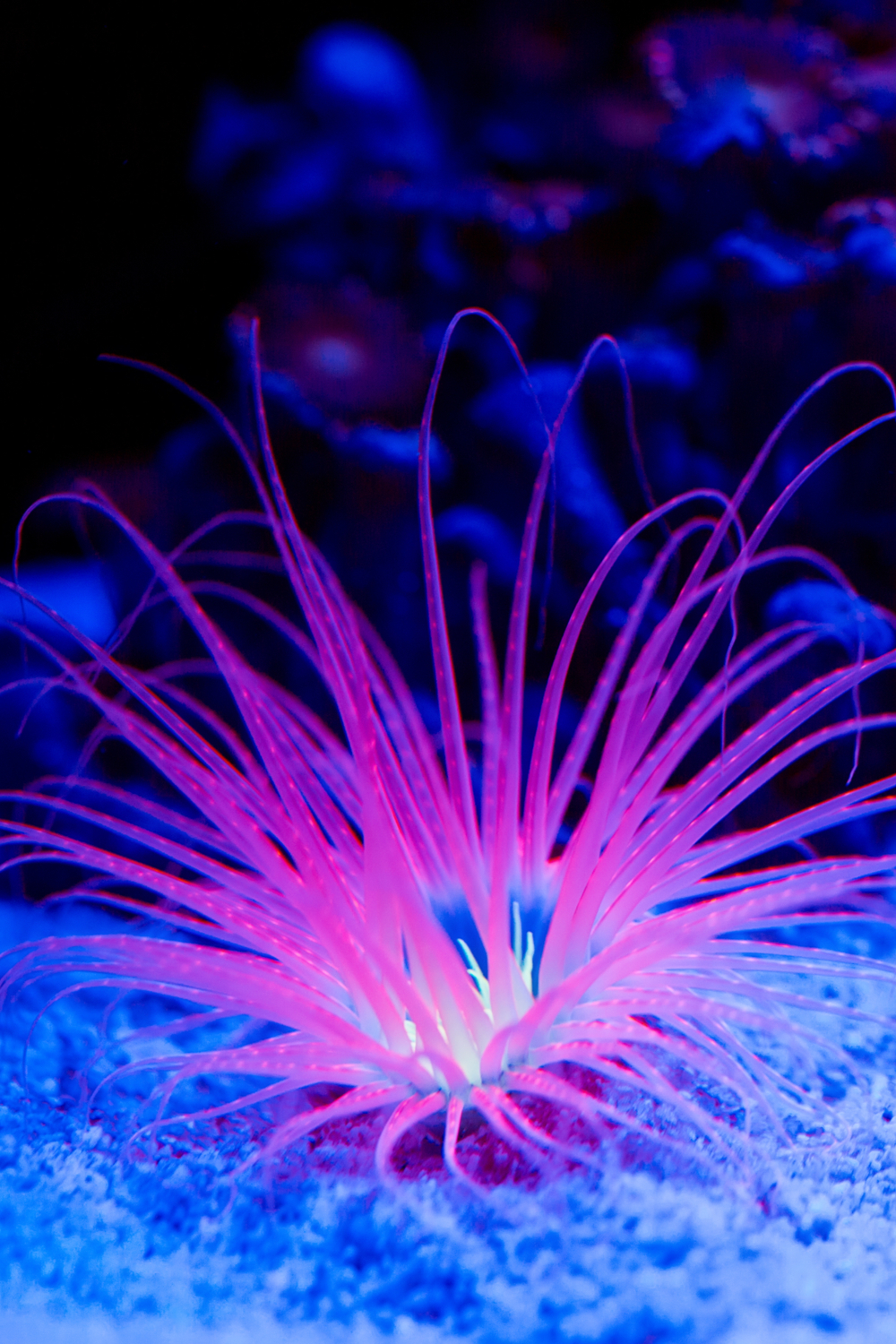Sea anemones are aquatic animals that belong to the order Actiniaria. They got their name after a colorful flower, which is the main characteristic of many anemone subspecies. You can find these animals at the bottom of seas and oceans, waiting for prey to come by so they can poison them with tentacles.
Many people wonder what do sea anemone eat. In this article, we will talk about the animal’s feeding habits and analyze its other interesting characteristics.
Sea Anemone Habits and biology
Besides the fact they are very colorful, this species is known for its predatory instincts. Their bodies consist of the foot, cylinder, pedal disc, and deadly tentacles placed in a circle around their mouth.
Biologists characterize the animal as a sessile polyp. They utilize their foot to stick to the surface. Most of them are between 2 to 10 centimeters in length and 1 to 5 centimeters in diameter. However, they can change size on a whim as they are able to inflate cylindrical bodies.
While most of them are really small, there are a few species that are quite enormous. Good examples are Stichodactyla mertensii and Urticina columbiana, which can be more than one meter in diameter, as well as Metridium farcimen, a species that can be up to one meter long.
As mentioned, their trunk is usually simple and cylindrical. In most species, it is smooth without any addition or distinguishing characteristics. However, they can also have cinclides, fleshy protuberances, adhesive papillae, and vesicles. The animal heavily relies on sphincter muscles for contractions and internal processes.
Here are some common sea anemone habits:
- The animal has a set of muscles stretching all along tentacles and columns. Not only does this tissue allow them to contract, but it also helps them twist and bend. Sea anemones can also suck food into their mouth and expel water from it.
- Most types of anemones attach themselves to hard surfaces such as stones, but some of them also burrow into the sand. They can stay in the same place for weeks and even months.
- The species relies on locomotion movement. When they want to change position, they will slowly start gliding on the surface. It is a very slow movement that can be hard to track with the naked eye.
- Although predatorial by nature, the animal creates a mutualistic relationship with algae. Through this relationship, algae get protection from micro-feeders, while anemones get food and oxygen that algae produce.
What do sea anemone eat in the wild?
Sea anemone can sense even the slightest movement in the water. So when a passing fish touches them, it stimulates tentacles that fire a filament. The prey is stung with a paralyzing toxin, and then the sea anemone will catch the unsuspecting animal with tentacles and guide it in its mouth.
Like many other species, sea anemones will not try to catch prey that is larger than them. Instead, they will only focus on things they can swallow. When the species catch fish, they will put it into their pharynx. They might also use their lips for this particular action (especially important when eating larger animals).
Here are the things that the animal eats:
- Small fish
- Crustaceans
- Mollusk
- Sea urchin
- Plankton
Although the species is mainly predatorial, it can feed in several ways and eat different kinds of food. Among others, they can act as parasites attaching themselves to other animals such as jellyfish. In such cases, infant anemone will eat away the animal’s tissue until it’s big enough to live on its own.
Certain species of anemones have a diet very similar to that of corals. They can store microscopic algae within their tissue, and by doing so, the animal will receive various nutrients and sugar. On the other hand, the algae will also receive certain nutrients as well as sea anemone’s protection.
The sea animal can benefit from various nutrients. However, a healthy amount of proteins is crucial for their development, and it affects propagation.
Scientists have observed that certain anemone species have preferences in terms of food. But, like other animals, they will eat just about anything when facing scarce resources and hunger. Their eating habits can have a major impact on other species. For example, they can thin the plankton population, which can significantly impact other marine life.
Some pet owners like having sea anemones in their tanks. In most cases, they require supplemental feeding in the form of shrimp and fish bits. It is very important for the owners to recreate the natural feeding processes. According to them, you can feed them thrice a week.
Facts about sea anemone
Given there are so many different types of sea anemone, the species exhibits various types of behavior. Their organs, characteristics, and diet can also vary significantly. Here are some fun facts about this predatorial sea animal:
- Based on what we know so far, there are more than 1,000 different types of anemones. Some of the most common ones are giant carpet anemone, aggregating anemone, magnificent anemone, giant green anemone, beadlet anemone, and snakelocks anemone.
- Besides their unique feeding method, most people recognize these animals for their flashy colors. The species comes in literally all colors, and you can find them at any depth. Furthermore, a few of them are fluorescent. Some anemones will be very small, while others can grow more than one meter long.
- Although this animal is very deadly, there are a few species immune to its poison. Clownfish is a good example of this. They can survive anemone’s sting due to the protective mucous layer. Since these two species are not a threat to each other, they often create a symbiotic bond. The fish helps anemones by eating parasites from their surface. It might also protect anemones by chasing away larger predators. On the other hand, clownfish can also find shelter with their host. In fact, this combination of animals has become so popular among hobbyists that it threatens some species.
- The animal can live a very long time. Some of them reach the age of 80. Among others, this is due to their great regenerative ability. In a sense, given they can clone themselves, their potential life span is indefinite.
- It is really hard to say why certain anemones move from the place. Most of them will stay in the same spot for a very long time, while some individuals are very mobile. When moving, they move at snail speed. The species slowly roll on the surface, but some of them might even do somersault or tumble. Occasionally, an anemone will simply detach itself from the surface and allow the tide to carry it in a certain direction. While floating, they might squirm a bit to change their general direction.
- The species can multiply in several ways. A lot of them will reproduce asexually. In such cases, they will create two twin individuals with the same traits as the parent. Such behavior leads to the creation of anemone colonies where all individuals look like one another. Besides asexual reproduction, they can also fertilize within the water. In such cases, small larvae will swim together with plankton and will remain with them until they find a suitable area to land. After that, they will start metamorphosis, creating young animals.
- Given their size and the fact they are fairly immobile, you would think that many species hunt sea anemones. However, the toxin from their tentacles can scare away many animals. Larger sea slugs, flounders, starfishes, and eels are usually immune to their poison and are more likely to attack them.
- Most species will not harm humans. However, a few of them, such as Phyllodiscus semoni and Actinodendron arboretum, which can cause serious damage and even death.
- The animal has an evolutionary connection to jellyfish and corals. Unlike jellyfish, they do not have a medusa stage during their lifetime. We can group all anemones in Anthozoa, Hexacorallia, and Cnidaria subclasses.
- An interesting thing about the animal is that their mouth is also their bottom.
- The animal is highly adaptable and can feed in numerous ways. As such, they can be found in various types of habitats. This includes lochs, muddy bodies of water, wrecks, reefs, and seashores. Some sea anemones can survive a long time out of the water by simply placing tentacles inside their mouths.
- Another interesting symbiotic relationship is that between boxer crabs and sea anemones. The crabs can carry them around on claws allowing anemones to feed as they go. On the other hand, anemones can protect the crabs by stinging attackers.
Summary
Anemones are one of the most beautiful inhabitants of the Deep. They have numerous methods of feeding and are very adaptable. By utilizing their strong toxin, they can incapacitate even larger animals. However, when they hunt, they usually attack animals smaller than them.
The species is very slow. Most of them barely move, and they do it by detaching foot from the surface when they do so. Then, they can slowly move on the ground or float on the water until they find the next suitable spot for taking roots.

